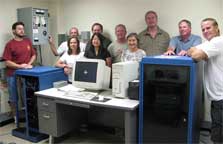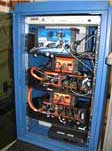USGS Deploys Its First Next Generation GSN Field System
The US Geological Survey Albuquerque Seismological Laboratory (ASL) installed its first next generation system (NGS) at the Global Seismographic Network (GSN) station ANMO in Albuquerque, New Mexico, on June 30, 2008. This upgrade uses a new GSN field system design developed jointly by the ASL and Project IDA based on the Quanterra Q330HR high-resolution data acquisition system. The NGS standardizes the stations of the GSN between the network operators, allowing more uniform installation, operation and maintenance techniques for the network. Rollout of the new systems across the entire GSN will take several years, but the design is now complete and the older obsolete, non-standard systems have a replacement.
Congratulations to the ASL and IDA for the culmination of the multi-year effort!

ASL NGS development and installation team. Left to right: Mark Robertson, Cynthia Segura, Ted Kromer, Eunsil Han, Don Anderson, Neil Ziegelman, Sue McLafferty, Frank Shelly, Kyle Persefield, and Jared Anderson. Team is comprised of both USGS personnel and staff from their prime contractor, Honeywell Technical Servicse, Inc.

NGS equipment rack. From Top to Bottom: Falcon monitoring device, Kinemetrics Slate field processor (blue box), Power distribution box (white box behind Slate), Quanterra Packet Baler (orange), Quanterra Q330HR (black/orange), and another Baler/330 combo completing the 12 channel system. This replaces the older Quanterra Q680 12 channel system.
The Albuquerque Seismological Laboratory is part of the US Geological Survey whose charge includes the maintenance of approximately 90 stations of the Global Seismographic Network. Station upgrades to the NGS design are made possible by a partnership between IRIS and the US Geological Survey. Project IDA (International Deployment of Accelerometers) is operated by the Institute of Geophysics and Planetary Physics at the Scripps Institution of Oceanography, University of California, San Diego and is funded by IRIS to operate about 40 stations in the Global Seismographic Network.


